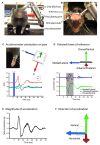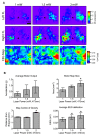Improved methods for chronic light-based motor mapping in mice: automated movement tracking with accelerometers, and chronic EEG recording in a bilateral thin-skull preparation
- PMID: 23966910
- PMCID: PMC3722499
- DOI: 10.3389/fncir.2013.00123
Improved methods for chronic light-based motor mapping in mice: automated movement tracking with accelerometers, and chronic EEG recording in a bilateral thin-skull preparation
Abstract
Optogenetic stimulation of the mouse cortex can be used to generate motor maps that are similar to maps derived from electrode-based stimulation. Here we present a refined set of procedures for repeated light-based motor mapping in ChR2-expressing mice implanted with a bilateral thinned-skull chronic window and a chronically implanted electroencephalogram (EEG) electrode. Light stimulation is delivered sequentially to over 400 points across the cortex, and evoked movements are quantified on-line with a three-axis accelerometer attached to each forelimb. Bilateral maps of forelimb movement amplitude and movement direction were generated at weekly intervals after recovery from cranial window implantation. We found that light pulses of ~2 mW produced well-defined maps that were centered approximately 0.7 mm anterior and 1.6 mm lateral from bregma. Map borders were defined by sites where light stimulation evoked EEG deflections, but not movements. Motor maps were similar in size and location between mice, and maps were stable over weeks in terms of the number of responsive sites, and the direction of evoked movements. We suggest that our method may be used to chronically assess evoked motor output in mice, and may be combined with other imaging tools to assess cortical reorganization or sensory-motor integration.
Keywords: accelerometer; chronic EEG; chronic window; cortex; motor mapping; mouse; optogenetics.
Figures





Similar articles
-
Displacement of sensory maps and disorganization of motor cortex after targeted stroke in mice.Stroke. 2013 Aug;44(8):2300-6. doi: 10.1161/STROKEAHA.113.001272. Epub 2013 Jun 6. Stroke. 2013. PMID: 23743973
-
Automated light-based mapping of motor cortex by photoactivation of channelrhodopsin-2 transgenic mice.Nat Methods. 2009 Mar;6(3):219-24. doi: 10.1038/nmeth.1303. Epub 2009 Feb 15. Nat Methods. 2009. PMID: 19219033
-
Distinct cortical circuit mechanisms for complex forelimb movement and motor map topography.Neuron. 2012 Apr 26;74(2):397-409. doi: 10.1016/j.neuron.2012.02.028. Neuron. 2012. PMID: 22542191
-
Motor cortex - to act or not to act?Nat Rev Neurosci. 2017 Oct 18;18(11):694-705. doi: 10.1038/nrn.2017.119. Nat Rev Neurosci. 2017. PMID: 29042690 Review.
-
Motor maps and the cortical control of movement.Curr Opin Neurobiol. 2014 Feb;24(1):88-94. doi: 10.1016/j.conb.2013.08.018. Epub 2013 Sep 21. Curr Opin Neurobiol. 2014. PMID: 24492084 Review.
Cited by
-
High-throughput automated home-cage mesoscopic functional imaging of mouse cortex.Nat Commun. 2016 Jun 13;7:11611. doi: 10.1038/ncomms11611. Nat Commun. 2016. PMID: 27291514 Free PMC article.
-
Mesoscale transcranial spontaneous activity mapping in GCaMP3 transgenic mice reveals extensive reciprocal connections between areas of somatomotor cortex.J Neurosci. 2014 Nov 26;34(48):15931-46. doi: 10.1523/JNEUROSCI.1818-14.2014. J Neurosci. 2014. PMID: 25429135 Free PMC article.
-
The role of forelimb motor cortex areas in goal directed action in mice.Sci Rep. 2017 Nov 17;7(1):15759. doi: 10.1038/s41598-017-15835-2. Sci Rep. 2017. PMID: 29150620 Free PMC article.
-
Through the looking glass: A review of cranial window technology for optical access to the brain.J Neurosci Methods. 2021 Apr 15;354:109100. doi: 10.1016/j.jneumeth.2021.109100. Epub 2021 Feb 15. J Neurosci Methods. 2021. PMID: 33600850 Free PMC article. Review.
-
Retinal and Callosal Activity-Dependent Chandelier Cell Elimination Shapes Binocularity in Primary Visual Cortex.Neuron. 2021 Feb 3;109(3):502-515.e7. doi: 10.1016/j.neuron.2020.11.004. Epub 2020 Dec 7. Neuron. 2021. PMID: 33290732 Free PMC article.
References
-
- Asanuma H., Sakata H. (1967) Functional organization of a cortical efferent system examined with focal depth stimulation in cats. J. Neurophysiol. 30 35–54
-
- Bonazzi L., Viaro R., Lodi E., Canto R., Bonifazzi C., Franchi G. (2013) Complex movement topography and extrinsic space representation in the rat forelimb motor cortex as defined by long-duration intracortical microstimulation. J. Neurosci. 33 2097–2107 10.1523/JNEUROSCI.3454-12.2013 - DOI - PMC - PubMed
Publication types
MeSH terms
LinkOut - more resources
Full Text Sources
Other Literature Sources

